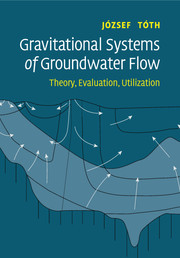Book contents
- Frontmatter
- Contents
- Preface
- 1 Introduction
- 2 The ‘Unit Basin’
- 3 Flow patterns in composite and heterogeneous basins
- 4 Gravity flow of groundwater: a geologic agent
- 5 Practical applications: case studies and histories
- 6 Epilogue: gravitational systems of groundwater flow and the science of hydrogeology
- Glossary
- References
- Appendices
- Appendix A
- Appendix B
- Index
5 - Practical applications: case studies and histories
Published online by Cambridge University Press: 31 July 2009
- Frontmatter
- Contents
- Preface
- 1 Introduction
- 2 The ‘Unit Basin’
- 3 Flow patterns in composite and heterogeneous basins
- 4 Gravity flow of groundwater: a geologic agent
- 5 Practical applications: case studies and histories
- 6 Epilogue: gravitational systems of groundwater flow and the science of hydrogeology
- Glossary
- References
- Appendices
- Appendix A
- Appendix B
- Index
Summary
Properties, controlling factors, and natural effects of gravity-driven groundwater flow were discussed in the previous chapters. Based on that understanding including theory, measured fluid-dynamic parameters, and field manifestations, it is possible to infer spatial patterns of flow systems that, in turn, can be useful in solving utilitarian problems of a widely variable nature. Examples include, but are far from limited to: basin-scale assessment of groundwater resources; locating favourable spots for water-supply wells; searching for areas suitable for specified land uses (the required characteristics of the area are specified, e.g., ‘find an area suitable for a municipal sewage lagoon’) or, the other way around, developing a site for use that is best suited to its natural characteristics (the characteristics of the available site are known, e.g., ‘this site is suitable for a municipal sewage lagoon’); predicting the consequences entailing modifications to current groundwater-related conditions; amelioration of undesirable environmental conditions (e.g., favourable or unfavourable ecological changes); diagnosing the causes of seemingly anomalous conditions in: pore pressures, soil mechanical behaviour (liquefaction, landslides), soil- and groundwater-chemistry, vegetation and geothermal heat flow, just to name a few. Indeed, the recognition and solution of such problems are limited only by the depth of understanding, scope of experience, and imagination of the hydro-geologist involved. The practical use and usefulness of groundwater flow-system studies is perhaps best epitomized by the various schematized versions of the composite flow-system pattern adorning several major texts, monographs and posters (Fig. 5.1).
- Type
- Chapter
- Information
- Gravitational Systems of Groundwater FlowTheory, Evaluation, Utilization, pp. 128 - 243Publisher: Cambridge University PressPrint publication year: 2009



